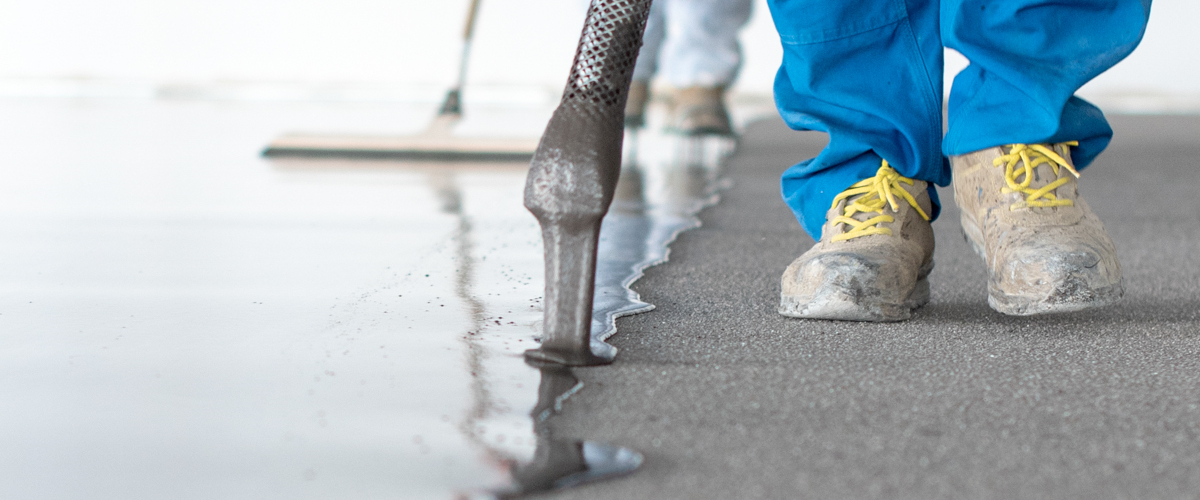Floor leveling
- Publicatie datum January 30, 2024
- Auteur Joost van Hulst
- Laatst aangepast January 30, 2024
 800
800 An essential part of laying a new floor is leveling the subfloor. In this article, we’ll take you through the world of floor leveling, covering different methods, suitable materials and helpful tips.
Leveling different substrates
Leveling a floor is very important for a sleek and durable end result. There are different methods for leveling a floor, depending on the substrate. Here we distinguish the following common floor types:
Concrete floor leveling
Levelling a concrete floor is a crucial step in preparing the floor for further finishing, such as laying tiles, laminate, vinyl or applying a coating.
To level a concrete floor, it is important to use a cementitious leveling mortar. This is because a cementitious mortar adheres well to concrete, which will provide a solid surface for the finishing floor.
Levelling a wooden floor
Leveling a wood floor requires a different approach. Here it is important to use a flexible leveling mortar suitable for wooden substrates.
By leveling a wood floor, you don’t have to remove the entire wood floor first. You can then simply level the floor and then apply the desired floor finish.
Not all wood floors can be leveled, for example, if there is too much spring in the floor or the floor is not straight or even crooked. For wood floors that can be leveled, we recommend a fiber-reinforced leveler.
Levelling anhydrite floors
Anhydrite floors have specific properties that require an appropriate leveling compound. For anhydrite floors, we therefore recommend a gypsum-bonded equalizer to achieve good adhesion to the substrate.
Which leveling agent to use for leveling a floor?
Choosing the right smoothing compound is essential for leveling a floor. For example, different substrates will have different requirements for the type of leveler you need.
At ICM Projects, we use high-quality leveling mortars that are suitable for different substrates. Our experts can advise you on the best choice for your specific situation.
How do you level a floor?
To give you an idea of the process of leveling a floor, we have prepared a general step-by-step plan for you below:
- Prepare substrate: make sure the floor is clean, dry and free of loose particles.
- Apply primer: apply an appropriate primer to ensure proper adhesion.
- Prepare smoothing compound: prepare the smoothing compound according to the instructions on the package.
- Levelling the floor: spread the levelling compound evenly on the floor and smooth it with a trowel.
- Drying: allow the floor to dry sufficiently before proceeding with the finish.
Depending on the substrate, the choice of a leveler and the final finish floor, the step-by-step process will look different.
Floor leveling for different floor finishes
In addition to the type of substrate, the type of floor finish also determines the method of leveling. At ICM Projects, we have experience leveling all types of substrates for a variety of floor finishes. Consider floor finishes such as:
- Concrete look floors
- ESD floors
- Cast floors
- Linoleum
- Marmoleum
- MMA floors
- Novilon vinyl
- PVC Floors
- Carpet
- Trowel floors
- Floor coatings
What does it cost to level a floor?
The cost of leveling a floor can vary depending on several factors, including the size and condition of the floor, the type of material used, the location and the difficulty of the project.
There may also be additional costs for any preparatory work, such as removing old flooring or repairing damage in the substrate.
Levelling a floor yourself or having a floor levelled
Leveling a floor is a specialized job that requires accuracy and expertise. If desired, you can choose to have the floor leveled by our experienced professionals. This guarantees a perfect end result and saves you precious time and effort.
Floor levelling by ICM Projects
At ICM Projects, we have years of experience in leveling floors for various applications. Our professionals work with the latest techniques and high-quality materials to perfectly level a floor. Feel free to contact us for a free advice and custom quote.
What is the drying time when leveling a floor?
The drying time of the leveled floor depends on several factors, including ambient temperature and humidity. In general, you should expect a few hours to a day before the floor is walkable.
How thick should you level a floor?
The required thickness of the leveling compound depends on the unevenness of the substrate. In most cases, a layer of 2 to 5 millimeters is sufficient. Deeper unevennesses may require a thicker layer. Also, the thickness of the leveling layer will depend on the type of substrate, the type of leveling and the final finishing floor.
What does egaline not adhere to?
Equalization does not adhere well to highly absorbent or powdery substrates. It is important to treat these substrates first with a suitable primer to ensure good adhesion.
OVER DE AUTEUR
Purchasing a company floor does not happen overnight. A good floor is only the basis for high work performance if you and your colleagues function optimally in it. For that simple reason, CEO Joost van Hulst makes sure every project runs smoothly every day. We get to the bottom of things for our clients. From administrative offices to hospitals. Ready to perform? The floor is yours.